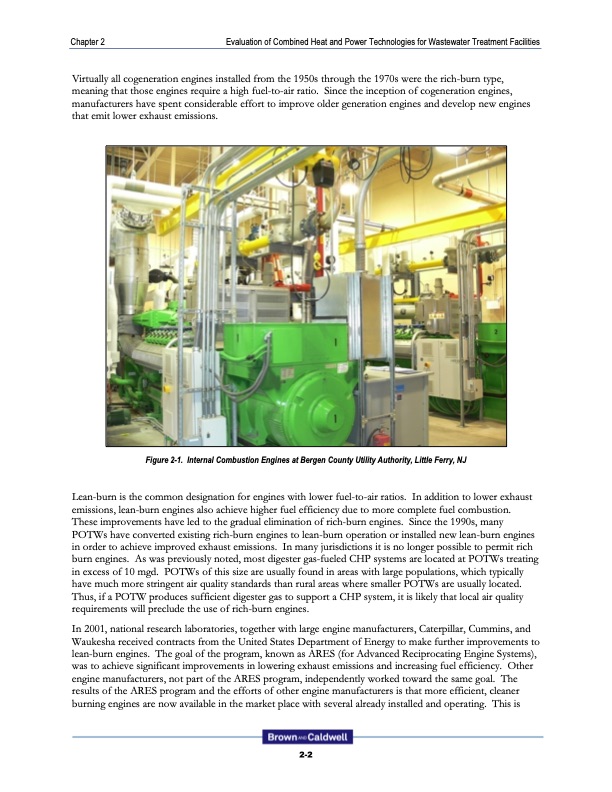
PDF Publication Title:
Text from PDF Page: 027
Chapter 2 Evaluation of Combined Heat and Power Technologies for Wastewater Treatment Facilities Virtually all cogeneration engines installed from the 1950s through the 1970s were the rich-burn type, meaning that those engines require a high fuel-to-air ratio. Since the inception of cogeneration engines, manufacturers have spent considerable effort to improve older generation engines and develop new engines that emit lower exhaust emissions. Figure 2-1. Internal Combustion Engines at Bergen County Utility Authority, Little Ferry, NJ Lean-burn is the common designation for engines with lower fuel-to-air ratios. In addition to lower exhaust emissions, lean-burn engines also achieve higher fuel efficiency due to more complete fuel combustion. These improvements have led to the gradual elimination of rich-burn engines. Since the 1990s, many POTWs have converted existing rich-burn engines to lean-burn operation or installed new lean-burn engines in order to achieve improved exhaust emissions. In many jurisdictions it is no longer possible to permit rich burn engines. As was previously noted, most digester gas-fueled CHP systems are located at POTWs treating in excess of 10 mgd. POTWs of this size are usually found in areas with large populations, which typically have much more stringent air quality standards than rural areas where smaller POTWs are usually located. Thus, if a POTW produces sufficient digester gas to support a CHP system, it is likely that local air quality requirements will preclude the use of rich-burn engines. In 2001, national research laboratories, together with large engine manufacturers, Caterpillar, Cummins, and Waukesha received contracts from the United States Department of Energy to make further improvements to lean-burn engines. The goal of the program, known as ARES (for Advanced Reciprocating Engine Systems), was to achieve significant improvements in lowering exhaust emissions and increasing fuel efficiency. Other engine manufacturers, not part of the ARES program, independently worked toward the same goal. The results of the ARES program and the efforts of other engine manufacturers is that more efficient, cleaner burning engines are now available in the market place with several already installed and operating. This is 2-2PDF Image | Combined Heat and Power Technologies for Wastewater Facilities

PDF Search Title:
Combined Heat and Power Technologies for Wastewater FacilitiesOriginal File Name Searched:
300_CHP-EPA-w-Apps.pdfDIY PDF Search: Google It | Yahoo | Bing
Capstone Turbine and Microturbine: Capstone microturbines used and new surplus for sale listing More Info
Consulting and Strategy Services: Need help with Capstone Turbine, sizing systems, applications, or renewable energy strategy, we are here to assist More Info
Container Lumber Dry Kiln: Since 1991 developing and innovating dry kilns using standard shipping containers More Info
Supercritical CO2 Lumber Dry Kiln: Compact fast drying in 3 days or less for small amounts of wood and lumber drying More Info
BitCoin Mining: Bitcoin Mining and Cryptocurrency... More Info
Publications: Capstone Turbine publications for microturbine and distributed energy More Info
FileMaker Software for Renewable Energy Developing database software for the renewable energy industry More Info
CO2 Gas to Liquids On-Demand Production Cart Developing a supercritical CO2 to alcohol on-demand production system (via Nafion reverse fuel cell) More Info
Stranded Gas for low cost power Bitcoin Mining Using stranded gas for generators may provide breakthrough low power costs for cryptocurrency miners. More Info
| CONTACT TEL: 608-238-6001 Email: greg@globalmicroturbine.com | RSS | AMP |